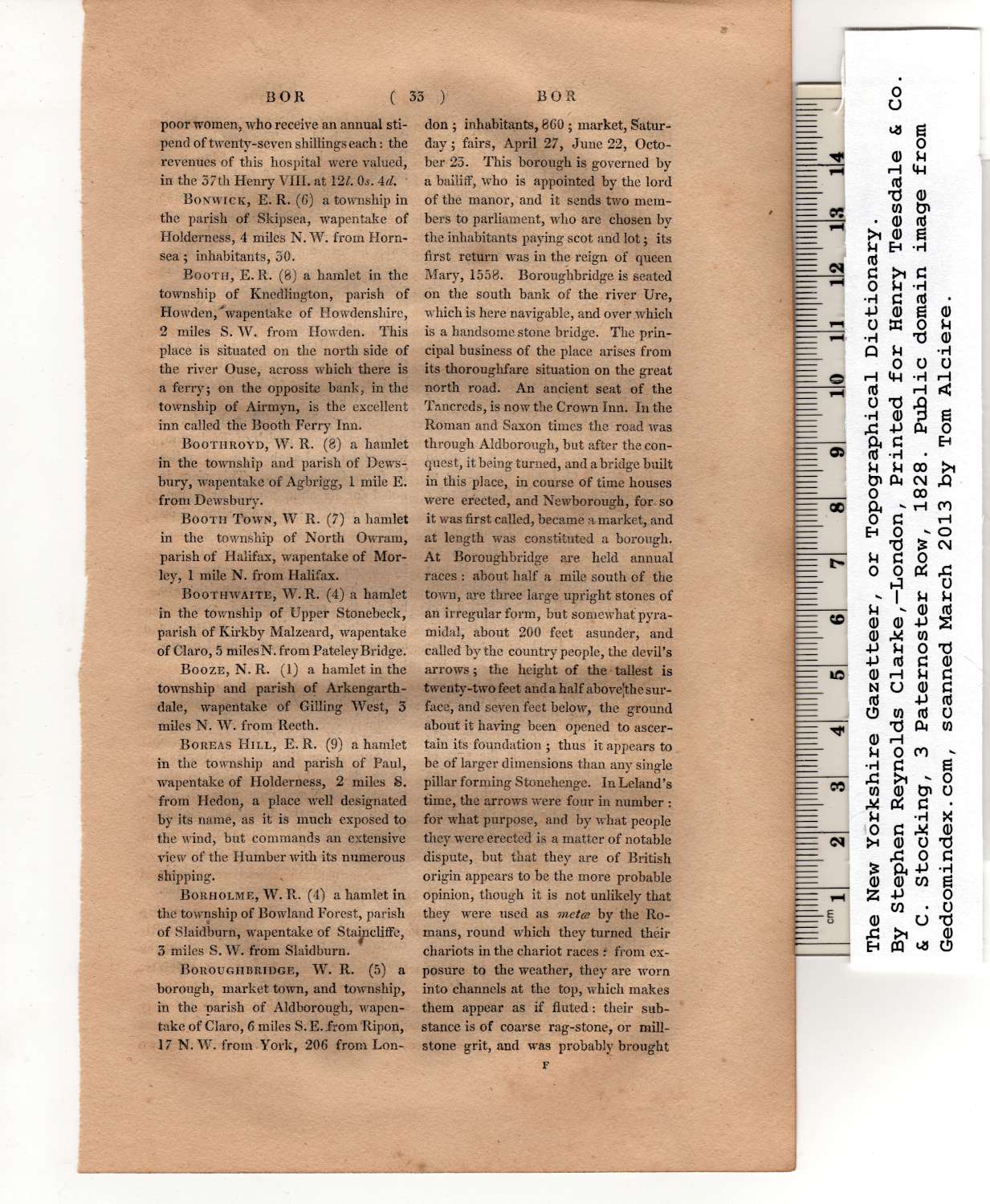|
poor women, who receive an annual sti-
pend of twenty-seven shillings each: the
revenues of this hospital were valued,
in the 37th Henry VIII. at 12/. Os. Ad.
Bonwick, E. R. (6) a township in
the parish of Skipsea, wapentake of
Holderness, 4 miles N. W. from Horn-
sea ; inhabitants, 30.
Booth, E. R. (8) a hamlet in the
township of Knedlington, parish of
Howden,'wapentake of Howdenshire,
2 miles S. W. from Howden. This
place is situated on the north side of
the river Ouse, across which there is
a ferry; on the opposite bank, in the
township of Airmyn, is the excellent
inn called the Booth Ferry Inn.
Boothroyd, W. R. (8) a hamlet
in the township and parish of Dews-
bury, wapentake of Agbrigg, 1 mile E.
from Dewsbury.
Booth Town, W R. (7) a hamlet
in the township of North Owram,
parish of Halifax, wapentake of Mor-
ley, 1 mile N. from Halifax.
BootIIwaite, W. R. (4) a hamlet
in the township of Upper Stonebeck,
parish of Kirkby Malzeard, wapentake
of Claro, 5 milesN. from Pateley Bridge.
Booze, N. R. (1) a hamlet in the
township and parish of Arkengarth-
dale, wapentake of Gilling West, 3
miles N. W. from Reeth.
Boreas Hill, E. R. (9) a hamlet
in the township and parish of Paul,
wapentake of Holderness, 2 miles S.
from Hedon, a place well designated
by its name, as it is much exposed to
the wind, but commands an extensive
view of the Humber with its numerous
shipping.
Borholme, W. R. (4) a hamlet in
the township of Bowland Forest, parish
of Slaidburn, wapentake of Staipcliffe,
3 miles S. W. from Slaidburn. |
Boroughbridge, W. R. (5) a
borough, market town, and township,
in the parish of Aldborough, wapen-
take of Claro, 6 miles S. E. from Ripon,
17 N. W. from York, 206 from Lon-
don ; inhabitants, 860 ; market, Satur-
day ; fairs, April 27, June 22, Octo-
ber 23. This borough is governed by
a bailiff, who is appointed by the lord
of the manor, and it sends two mem-
bers to parliament, who are chosen by
the inhabitants paying scot and lot; its
first return was in the reign of queen
Mary, 1558. Boroughbridge is seated
on the south bank of the river Ure,
which is here navigable, and over which
is a handsome stone bridge. The prin-
cipal business of the place arises from
its thoroughfare situation on the great
north road. An ancient seat of the
Tancreds, is now the Crown Inn. In the
Roman and Saxon times the road was
through Aldborough, but after the con-
quest, it being turned, and a bridge built
in this place, in course of time houses
were erected, and Newborough, for so
it was first called, became a market, and
at length was constituted a borough.
At Boroughbridge are held annual
races : about half a mile south of the
town, are three large upright stones of
an irregular form, but somewhat pyra-
midal, about 200 feet asunder, and
called by the country people, the devil’s
arrows; the height of the tallest is
twenty-two feet and a half above’the sur-
face, and seven feet below, the ground
about it having been opened to ascer-
tain its foundation ; thus it appears to
be of larger dimensions than any single
pillar forming Stonehenge. In Leland’s
time, the arrows were four in number :
for what purpose, and by what people
they were erected is a matter of notable
dispute, but that they are of British
origin appears to be the more probable
opinion, though it is not unlikely that
they were used as metes by the Ro-
mans, round which they turned their
chariots in the chariot races r from ex-
posure to the weather, they are worn
into channels at the top, which makes
them appear as if fluted: their sub-
stance is of coarse rag-stone, or mill-
stone grit, and was probably brought
r |
